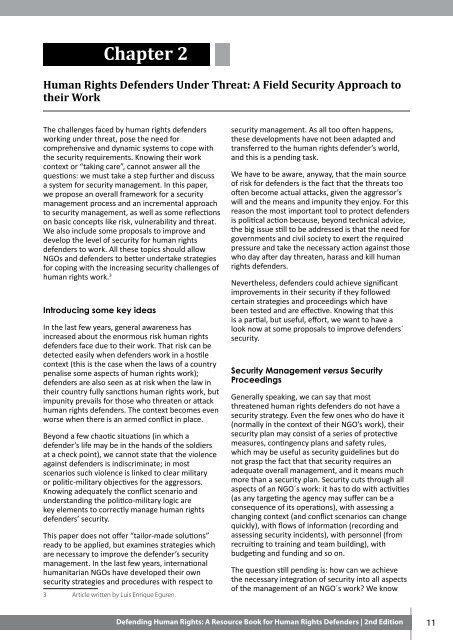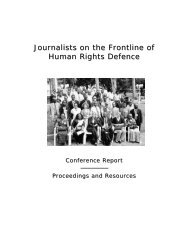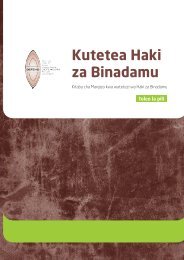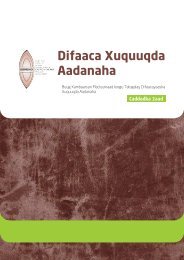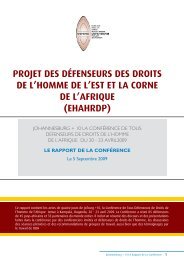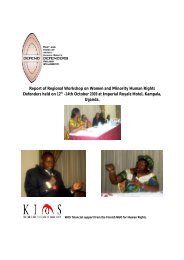Defending Human Rights: A Resource Book for Human
Defending Human Rights: A Resource Book for Human
Defending Human Rights: A Resource Book for Human
You also want an ePaper? Increase the reach of your titles
YUMPU automatically turns print PDFs into web optimized ePapers that Google loves.
Chapter 2<br />
<strong>Human</strong> <strong>Rights</strong> Defenders Under Threat: A Field Security Approach to<br />
their Work<br />
The challenges faced by human rights defenders<br />
working under threat, pose the need <strong>for</strong><br />
comprehensive and dynamic systems to cope with<br />
the security requirements. Knowing their work<br />
context or “taking care”, cannot answer all the<br />
questions: we must take a step further and discuss<br />
a system <strong>for</strong> security management. In this paper,<br />
we propose an overall framework <strong>for</strong> a security<br />
management process and an incremental approach<br />
to security management, as well as some reflections<br />
on basic concepts like risk, vulnerability and threat.<br />
We also include some proposals to improve and<br />
develop the level of security <strong>for</strong> human rights<br />
defenders to work. All these topics should allow<br />
NGOs and defenders to better undertake strategies<br />
<strong>for</strong> coping with the increasing security challenges of<br />
human rights work. 3<br />
Introducing some key ideas<br />
In the last few years, general awareness has<br />
increased about the enormous risk human rights<br />
defenders face due to their work. That risk can be<br />
detected easily when defenders work in a hostile<br />
context (this is the case when the laws of a country<br />
penalise some aspects of human rights work);<br />
defenders are also seen as at risk when the law in<br />
their country fully sanctions human rights work, but<br />
impunity prevails <strong>for</strong> those who threaten or attack<br />
human rights defenders. The context becomes even<br />
worse when there is an armed conflict in place.<br />
Beyond a few chaotic situations (in which a<br />
defender’s life may be in the hands of the soldiers<br />
at a check point), we cannot state that the violence<br />
against defenders is indiscriminate; in most<br />
scenarios such violence is linked to clear military<br />
or politic-military objectives <strong>for</strong> the aggressors.<br />
Knowing adequately the conflict scenario and<br />
understanding the politico-military logic are<br />
key elements to correctly manage human rights<br />
defenders’ security.<br />
This paper does not offer “tailor-made solutions”<br />
ready to be applied, but examines strategies which<br />
are necessary to improve the defender’s security<br />
management. In the last few years, international<br />
humanitarian NGOs have developed their own<br />
security strategies and procedures with respect to<br />
3 Article written by Luis Enrique Eguren.<br />
security management. As all too often happens,<br />
these developments have not been adapted and<br />
transferred to the human rights defender’s world,<br />
and this is a pending task.<br />
We have to be aware, anyway, that the main source<br />
of risk <strong>for</strong> defenders is the fact that the threats too<br />
often become actual attacks, given the aggressor’s<br />
will and the means and impunity they enjoy. For this<br />
reason the most important tool to protect defenders<br />
is political action because, beyond technical advice,<br />
the big issue still to be addressed is that the need <strong>for</strong><br />
governments and civil society to exert the required<br />
pressure and take the necessary action against those<br />
who day after day threaten, harass and kill human<br />
rights defenders.<br />
Nevertheless, defenders could achieve significant<br />
improvements in their security if they followed<br />
certain strategies and proceedings which have<br />
been tested and are effective. Knowing that this<br />
is a partial, but useful, ef<strong>for</strong>t, we want to have a<br />
look now at some proposals to improve defenders´<br />
security.<br />
Security Management versus Security<br />
Proceedings<br />
Generally speaking, we can say that most<br />
threatened human rights defenders do not have a<br />
security strategy. Even the few ones who do have it<br />
(normally in the context of their NGO’s work), their<br />
security plan may consist of a series of protective<br />
measures, contingency plans and safety rules,<br />
which may be useful as security guidelines but do<br />
not grasp the fact that that security requires an<br />
adequate overall management, and it means much<br />
more than a security plan. Security cuts through all<br />
aspects of an NGO´s work: it has to do with activities<br />
(as any targeting the agency may suffer can be a<br />
consequence of its operations), with assessing a<br />
changing context (and conflict scenarios can change<br />
quickly), with flows of in<strong>for</strong>mation (recording and<br />
assessing security incidents), with personnel (from<br />
recruiting to training and team building), with<br />
budgeting and funding and so on.<br />
The question still pending is: how can we achieve<br />
the necessary integration of security into all aspects<br />
of the management of an NGO´s work We know<br />
<strong>Defending</strong> <strong>Human</strong> <strong>Rights</strong>: A <strong>Resource</strong> <strong>Book</strong> <strong>for</strong> <strong>Human</strong> <strong>Rights</strong> Defenders | 2nd Edition 11


